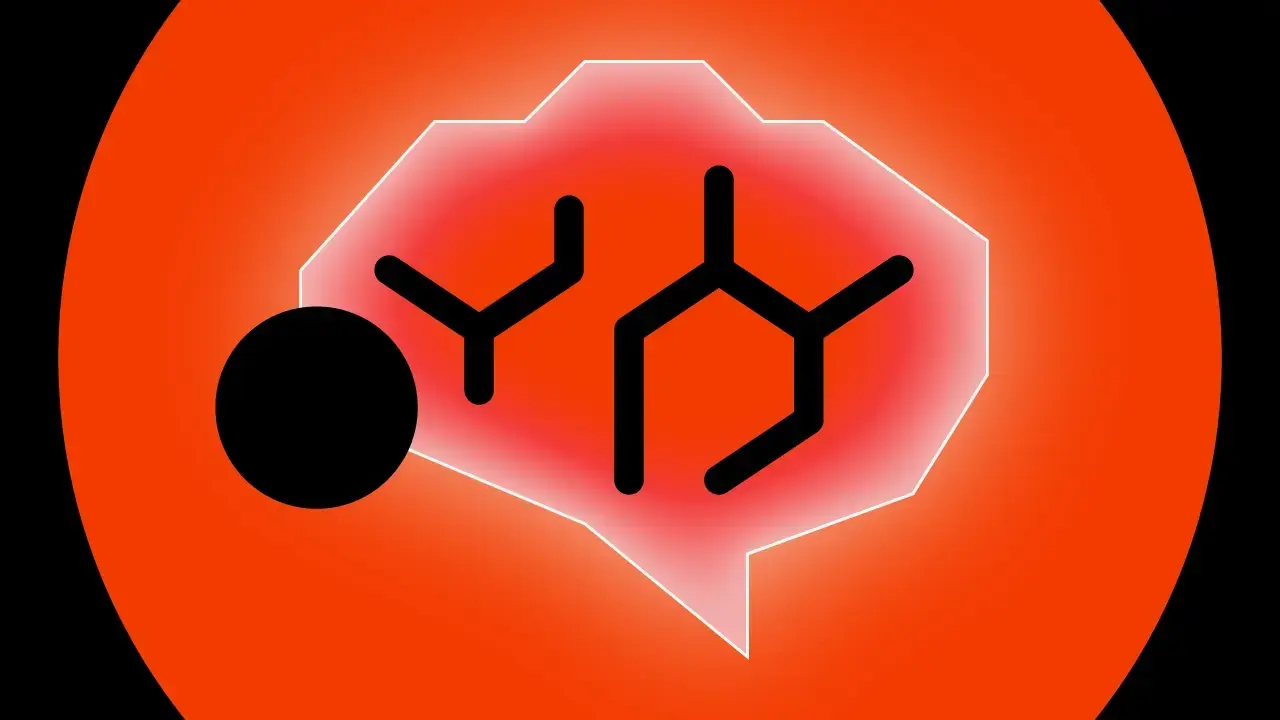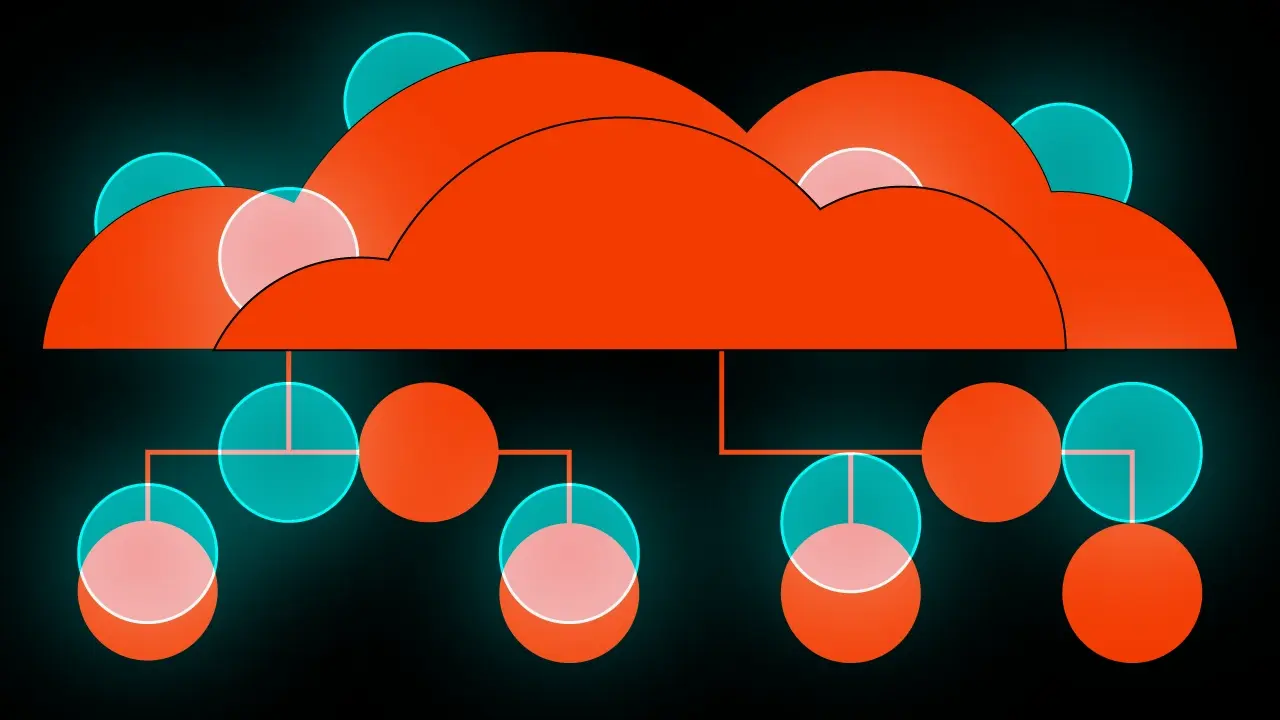Mastering the Discovery Product process: essential steps and tools

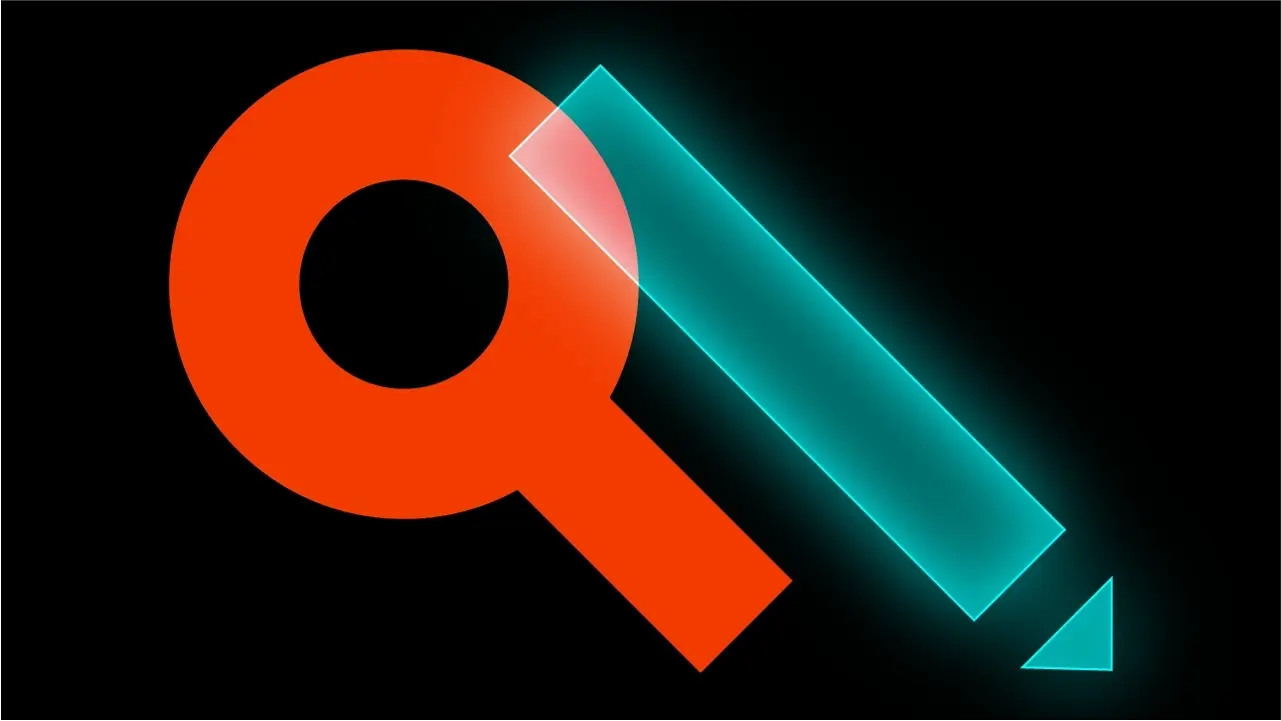
A significant percentage of new products fail simply because they address no real market need – a common, expensive mistake highlighting the risk of starting with assumptions.
Thankfully, this outcome is largely avoidable through data-driven product discovery workshops. This guide explores how these collaborative process sessions provide a crucial framework for understanding users, validating ideas with evidence, and ensuring product teams build what customers truly want before committing significant resources, covering the key product discovery phases, techniques, benefits, and deliverables involved in this crucial part of product management.
It is worth noting that although workshops can be conducted internally, support from external teams, such as experienced technology partners or a product discovery coach, can be valuable at various stages, though not always essential for the entire development lifecycle.
Table of contents
A. Goals of product discovery
Understanding the problem space represents a fundamental objective of the workshop. Teams must gain profound user insights into the challenges, needs, and motivations of their target audience. Clearly defining the specific problem the discovery product intends to solve prevents building something nobody wants.
Often, at this stage, the external partner’s role involves facilitating the thought process within the company, aiding objectification and asking questions that might be missed internally; however, key decisions regarding business goals remain the client’s responsibility.
Defining a compelling product vision constitutes another vital goal. This involves establishing the product’s purpose, identifying what makes it unique (its Unique Selling Proposition or USP), and ensuring this vision aligns with measurable business aims and the overall business strategy. Without a clear vision, the project lacks direction and focus.
Achieving alignment among all stakeholders on this vision and the subsequent goals is paramount for cohesive progress. Exploring potential solutions forms a core part of the workshop activities where participants brainstorm various ways to address the identified user problem.
Critically, the discovery process involves prioritising features to define an initial version, often called a Minimum Viable Product (MVP), focusing on delivering core business value quickly. Early validation of these solution ideas with actual users through user testing is essential to confirm desirability.
Assessing the feasibility of proposed solutions also requires careful consideration during discussions that cover technical possibilities and limitations involving the development team. Identifying potential risks, such as product-market fit or usability testing issues, is crucial for proactive planning. Developing strategies to lessen these risks increases the chances of success.
Defining how success will be measured is an indispensable goal. The team needs to agree on specific Key Performance Indicators (KPIs), which are quantifiable measures used to track progress towards objectives. Examples could include metrics related to user adoption, satisfaction, or engagement. These key metrics provide a clear way to evaluate the product’s performance after launch.
Ensuring all stakeholders are aligned is perhaps the overarching objective that enables all others. The workshop provides a dedicated forum for everyone involved to develop a shared understanding of the product’s vision, goals, scope, and priorities.
This shared context prevents misunderstandings and fosters collective ownership throughout the development process. Effective communication and collaboration are central to achieving this alignment, often involving cross-functional teams.
Key takeaways regarding goals:
Workshops serve as a powerful tool to reduce the risks inherent in product development, validating ideas before any code is written. This upfront investment saves significant time and resources down the line.
The objectives are multifaceted, encompassing a deep understanding of users, setting a clear product vision, and exploring potential solutions. They also include assessing feasibility and risks, defining success key metrics (KPIs), and ensuring robust stakeholder alignment.
Ultimately, the process systematically connects identified customer needs with tangible business goals. This ensures the final product is not only desirable for users but also contributes effectively to the organisation’s strategic objectives. Building this bridge is fundamental to creating truly successful products.
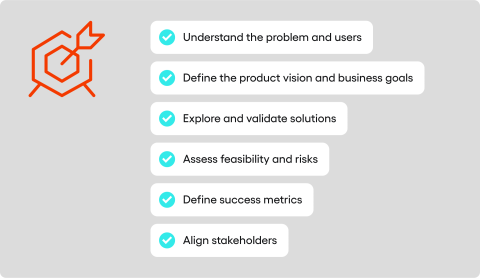
B. Typical phases in product discovery
Product discovery typically unfolds through a series of structured product discovery phases, although flexibility is key to adapt the product discovery process to specific project needs and complexities. Generally, these phases ensure a logical flow from initial research to actionable outputs. The structure provides a framework for systematic exploration and validation.
Collaboration with an external partner can be particularly valuable in executing specific elements of these phases, even if the company decides to lead product discovery primarily internally.
Phase 1: Pre-workshop research and preparation
Gathering initial insights marks the beginning of the journey. This involves preliminary user research, which might include conducting initial customer interviews or sending out user surveys to understand user behavior, needs and pain points.
Analysing the market trends and competitor offerings (existing solutions) provides essential context, while reviewing existing data yields further valuable information. Defining clear business goals for the workshop itself is a critical preparatory step.
Based on these goals, a detailed agenda should be created, outlining the activities, timings, and required participants (team participation) for each session. Proper preparation ensures the workshop time is used effectively and efficiently.
Compiling and sharing relevant background information with all participants before the workshop is also important. This pre-reading material helps everyone arrive with a basic understanding. It allows the workshop sessions to dive deeper into collaborative activities more quickly.
Phase 2: Core workshop sessions
This phase involves intensive collaboration among the workshop participants, with activities designed to move from understanding the problem to defining a potential solution.
Techniques like empathy mapping help the team step into the users’ shoes, while creating user personas provides concrete representations of the target audience. Brainstorming sessions, often using prompts like “How Might We…” questions, encourage creative thinking to generate a wide range of potential solutions.
In this phase, an external partner often adds value by helping to devise what should be designed and how, in order to achieve the previously established business goals. Further activities focus on structuring and prioritising these ideas, sometimes using tools like an Opportunity Solution Tree.
User story mapping helps visualise the user flows and interaction with the potential product, identifying the essential steps for a core experience. Prioritisation frameworks, such as MoSCoW (Must have, Should have, Could have, Won’t have this time), assist the team in deciding which features are crucial for the Minimum Viable Product (MVP) – identifying the most valuable features.
Discussions around the technical approach and feasibility, involving the development team and potentially delivery teams, are integrated throughout these activities. Defining initial success key metrics also occurs during these core sessions.
The duration can vary significantly depending on complexity, from a single day to a week or more, allowing sufficient time for deep discussion and decision-making.
Phase 3: Post-workshop synthesis and documentation
Following the intensive workshop sessions, the focus shifts to consolidating the findings and decisions into a coherent set of actionable deliverables. Raw ideas and discussion points need to be refined and documented clearly.
This synthesis ensures the valuable insights and agreements generated during the workshop are not lost. The team compiles artefacts such as finalised user personas, detailed customer journey mapping, and a prioritised product backlog outlining the features for development.
Initial prototypes or wireframes are cleaned up, and a comprehensive summary report captures key decisions, rationale, risks, and next steps. It translates the collaborative effort into tangible assets that will directly guide subsequent design and development phases, informing product delivery.
Key takeaways regarding phases:
The product discovery process typically involves distinct phases, starting with thorough preparation before the main event which gathers initial data and sets a clear agenda. Core workshop sessions form the heart of the process, characterised by intensive collaboration to understand users, brainstorm solutions, and define the MVP scope.
Finally, a post-workshop phase focuses on synthesis and documentation, compiling findings into actionable outputs that guide development.
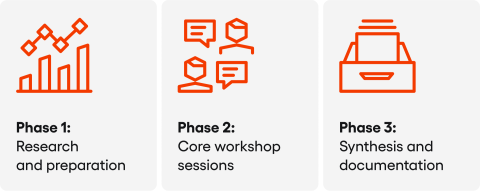
C. Expected outcomes and deliverables
A well-executed product discovery workshop produces several tangible and intangible outcomes that provide a solid foundation for the development process. These deliverables serve as crucial reference points and guides for the entire team. They represent the culmination of the collaborative process.
Thanks to collaboration with an experienced partner during PD, clients often solidify the discovery product and the desired outcome, as well as define or redefine their business goals.
Validated product vision & strategy
One primary outcome is a clearly articulated and validated understanding of the product’s direction. This includes a refined problem statement, a compelling product vision describing the desired future state, and a strong value proposition, forming a core part of the product strategy. Tools like the Lean Canvas can help structure and summarise this strategic view effectively.
Deep user understanding
The workshop synthesises research into concrete artefacts that foster empathy and guide design decisions. User personas, semi-fictional representations based on research, help focus on specific customer needs.
Empathy maps detail user thoughts and feelings, while customer journey mapping visualises their experience, highlighting pain points and opportunities. Analysis of pain points and user experiences helps uncover a broader context and identify the optimal solution.
Defined MVP scope
A critical deliverable is a clear definition of the Minimum Viable Product (MVP), often represented as a prioritised product backlog or user story map. This defined scope prevents wasted effort on non-essential features early on, focusing development on delivering core business value first. It ensures the team builds the most important elements initially.
Initial design & technical approach
The workshop often produces initial concepts for the user interface and user experience, ranging from simple sketches to detailed wireframes or interactive prototypes (low or high-fidelity) for early usability testing.
Alongside design concepts, initial discussions about the technical approach inform feasibility assessments. Product discovery tools like Figma are commonly used for creating higher-fidelity prototypes.
High-level roadmap & estimates
While detailed planning happens later, the workshop yields a high-level product roadmap outlining potential future phases beyond the initial MVP. Based on the defined MVP scope and initial technical discussions, the team develops preliminary time and resource estimates.
Understanding discovery might consume roughly 10% of the total project budget helps planning resource allocation. As a result, the product vision evolves into a concrete product roadmap – the team knows what they want to do, how it will look, and how it will function over a defined timeframe. Frequently, the scope for the future project is also established in a way that allows market research for cost estimation by potential contractors.
Product success metrics
The workshop solidifies the Key Performance Indicators (KPIs) that will be used to measure the product’s success after launch. Defining these key metrics early ensures that the team knows what ‘good’ looks like. It allows tracking progress towards achieving the desired outcomes.
Risk assessment
A crucial outcome is the identification and documentation of key risks associated with the product, including product-market fit, usability, adoption, and technical complexities. Importantly, the workshop also explores initial ideas for mitigating these risks. This promotes proactive risk management from the outset.
Key takeaways regarding outcomes:
Successful product discovery workshops generate deliverables like a validated vision, user insight artefacts (personas, maps), and a defined MVP scope. Initial designs, a product roadmap, preliminary estimates, success key metrics, and a risk assessment complete the set. Collectively, these provide essential clarity and direction for development.
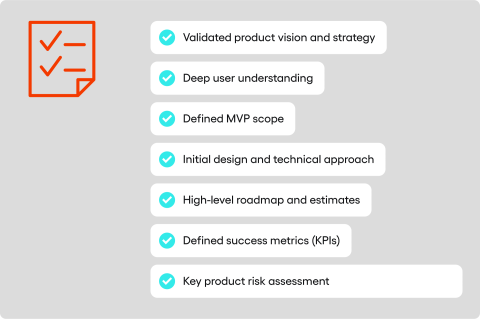
D. Quantifiable benefits of product discovery
Investing time and resources into thorough product discovery efforts yields significant, often quantifiable, advantages. By systematically de-risking the product development effort before major investment occurs, discovery delivers tangible returns. Product discovery helps teams shift the focus from simply building features to building the right features for the right audience.
Reduced waste & cost savings
Perhaps the most direct benefit is the prevention of wasted effort on features that users do not need or want. Building the wrong product is incredibly expensive, and discovery helps avoid costly rework later.
Some industry analyses suggest effective discovery can lead to potentially significant cost reductions in overall development. This allows for better project budget management – verifying hypotheses at this stage offers substantial savings, maximizing business value.
Increased likelihood of product success
Focusing intensely on validating user needs dramatically increases the likelihood of achieving product-market fit, where a product satisfies strong market demand. As mentioned, launching products without confirming market need is a primary reason many fail. Discovery efforts directly tackle this risk by ensuring the product addresses a genuine, validated problem identified through customer research.
Faster time-to-market (for the right product)
While seemingly counter-intuitive, upfront discovery can accelerate the delivery process of a valuable product. Clarity on vision, scope, and MVP streamlines development, preventing delays caused by confusion or scope creep. This focus allows the right product to reach users faster.
Improved team alignment & collaboration
The collaborative process nature of discovery workshops fosters shared understanding and collective ownership. When everyone participates in defining the problem and solutions, alignment improves naturally across cross-functional teams.
This leads to better communication, more informed decision-making, and increased commitment from the entire team, including customer-facing teams. Additionally, this process helps develop or uncover competencies among employees involved in the workshops, making further project collaboration much easier and more effective. It also helps eliminate the phenomenon of “tribal knowledge”.
Clearer requirements & better estimates
A key outcome is a well-defined set of requirements for the MVP, stemming from research, validation, and prioritisation. Having clearer, validated requirements allows development teams to provide more reliable initial estimates. Estimates based on discovery are significantly more grounded than those based on assumptions alone.
Key takeaways regarding benefits:
Investing in product discovery delivers measurable cost savings by avoiding wasted development effort. It significantly boosts the chances of achieving product-market fit by focusing on validated user needs.
Discovery can accelerate time-to-market for the right product and improves team alignment, develops internal competencies, yielding clearer requirements for better estimates.
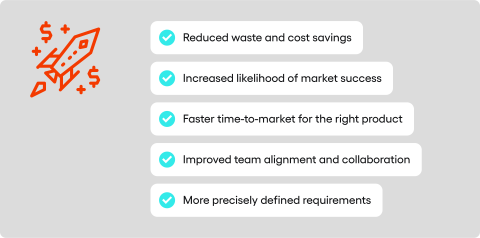
Key themes in data-driven product discovery
Effective data-driven product discovery workshops are typically structured around several interconnected themes, providing a logical framework for comprehensive exploration. These themes move from understanding the initial opportunity to planning the concrete steps forward. Each theme builds upon the previous one, creating a coherent narrative for the product manager and team.
Theme 1: Understanding the opportunity
Before any meaningful discussion about solutions can occur, establishing a deep, evidence-based understanding of the opportunity is paramount. This foundational theme ensures the team addresses a genuine, well-defined problem within a realistic market context. Data plays an indispensable role here, moving beyond mere assumptions.
A. Defining the problem and business goals
The discovery process begins by rigorously clarifying the fundamental “why” behind the potential product, requiring precise definition and alignment. This involves articulating the problem clearly and connecting it to strategic business objectives. Setting initial thoughts on success key metrics early is also beneficial.
Articulating the problem
Clearly articulating the specific user problem or unmet need is the critical starting point. Techniques like the “5 Whys” help uncover root causes rather than just surface-level symptoms. Data gathered from initial user research should validate and refine this problem definition.
Aligning on business objectives
Understanding the user problem must connect to the organisation’s broader strategic objectives and business strategy. The workshop translates the user need into measurable business goals, like increasing retention or revenue. Frameworks like the Lean Canvas facilitate this alignment and ensure stakeholder buy-in.
Setting success metrics (initial)
Defining high-level Key Performance Indicators (KPIs) early helps crystallise what the product aims to achieve. These initial key metrics might be broad, such as adoption rate or user satisfaction targets. Setting preliminary targets ensures success is considered from the outset.
Key takeaways regarding problem definition:
Clearly articulate the core user problem using techniques like 5 Whys and validate with data. Align the problem with measurable business objectives using tools like Lean Canvas. Define initial high-level success key metrics early in the process.
B. User research: Understanding needs and pains
Direct interaction with and observation of potential users is fundamental to understanding the opportunity deeply. User research provides necessary external perspective and evidence, moving beyond internal assumptions. Various methods gather rich user insights into user behaviours, motivations, and pain points.
User interviews
Conducting qualitative user interviews with 5-10 representative users often reveals key patterns and experiences. These customer interviews should focus on understanding current challenges using techniques like the “Mom Test” for honest customer feedback. Analysing transcripts identifies recurring themes.
Surveys
User surveys gather quantitative data and qualitative data from larger samples, useful for validating findings or assessing prevalence of needs. Well-designed surveys use mixed question types. Online tools make distribution and analyzing data straightforward.
User personas and empathy maps
Insights gathered need synthesis into formats like user personas (semi-fictional user representations based on data) and empathy maps (visualising user thoughts, feelings, actions). These data-informed artefacts foster empathy within the team. They serve as constant reminders of the target audience and the user perspective.
Customer journey mapping
Visualising the user’s current experience related to the problem occurs through customer journey mapping. This maps steps, actions, thoughts, and emotions to identify friction points and opportunities. The journey map makes the user’s process tangible.
Key takeaways regarding user research:
User interviews provide deep qualitative insights, while user surveys offer breadth from larger samples. User personas, empathy maps, and journey maps synthesise research to build empathy, guide design, and highlight opportunities. These tools make customer needs concrete.
C. Market and competitor analysis
Understanding the broader context is crucial, informing strategic positioning and validating business viability. Market and competitor analysis provides an external view beyond the immediate user problem. It considers existing solutions and industry movements (market trends).
Competitor research
Systematically analysing direct and indirect competitors involves examining their products, features, pricing, and user reviews (e.g., on G2, Capterra). This analysis helps identify strengths, weaknesses, and potential market gaps for differentiation. Tools like Similarweb offer insights into market share.
Theme 2: Defining the solution
Following a thorough exploration of the opportunity, the focus shifts towards envisioning and shaping the actual product solution. This theme encompasses creative ideation, critical prioritisation for an MVP, and practical prototyping for testing. It bridges the gap between understanding need and conceptualising response.
A. Ideation and brainstorming
Generating a diverse pool of potential solutions is the goal, emphasizing quantity and creativity initially without premature criticism. Structured techniques like “How Might We” questions reframe challenges as opportunities to spark ideas, including potential feature ideas. This shifts the mindset from problems to possibilities.
Brainstorming/Brainwriting
Classic brainstorming or variations like brainwriting (silent individual idea generation first) encourage broad team participation. Using visual collaboration product discovery tools like Miro aids remote contribution. The key principle is deferring judgment during idea generation.
Sketching/Storyboarding
Visualising potential solutions makes abstract ideas concrete. Quick sketching shows simple interfaces or user flows, while storyboarding illustrates user interaction sequences. These visual artefacts facilitate communication and help uncover potential issues early.
Key takeaways regarding ideation:
Use HMW questions, brainstorming, and sketching to generate diverse solution ideas, focusing on quantity first. Defer judgment during generation. Visual methods facilitate clearer communication and early concept exploration.
B. Defining and prioritising the MVP
Once ideas are generated, defining the Minimum Viable Product (MVP) scope is crucial. It’s the smallest version delivering core value for learning. Effective prioritisation, often using visual user story mapping, identifies the essential user workflow. This helps focus initial development efforts.
Feature prioritisation
Frameworks like MoSCoW (Must, Should, Could, Won’t) or impact-effort matrices help decide which features are critical versus optional for the MVP. Involving developers is essential for realistic feasibility and effort estimations. This ensures achievable scope decisions when deciding how to prioritize solutions.
MVP definition
The outcome is a clear MVP definition, documenting its core value, target users, included features, and key hypotheses to test. This documentation ensures shared understanding and prevents scope creep. It guides the development team effectively.
Key takeaways regarding MVP definition:
Define the MVP using user story mapping and prioritisation frameworks (e.g., MoSCoW), involving developers for feasibility input. Clearly document the MVP scope, its core value, target users, and goals. This provides essential clarity for development.
C. Prototyping
Creating tangible representations (prototypes) is critical before committing to development, allowing interaction and user feedback for iteration. Low-fidelity prototypes (sketches, basic wireframes) focus on structure and flow for quick iteration. They are cheap and fast to create and modify.
High-fidelity prototypes (detailed, clickable mockups using tools like Figma) simulate the final look, feel, and interactions. They are useful for realistic usability testing and precise communication. Though more time-consuming, they provide richer feedback on details.
Prototypes serve as powerful communication tools, align understanding, and facilitate early identification of usability issues through user testing. Most importantly, they are essential artefacts for gathering user feedback directly. This enables evidence-based iteration and validation.
Key takeaways regarding prototyping:
Use low-fidelity prototypes for early flow exploration and high-fidelity for realistic testing and communication. Prototypes aid communication, enable iteration through feedback, and are essential for validating solutions with users before development investment. They make ideas tangible.
Theme 3: Validation and Iteration (often part of Continuous Discovery)
Validation activities inevitably uncover issues. Acting upon this customer feedback by refining the solution through iteration is crucial.
Iteration is the cyclical process: build (prototype) -> test (validate through user testing) -> learn -> modify (iterate). This loop repeats, improving the solution and increasing confidence each time. This is central to continuous product discovery.
Feedback might lead to minor refinements or major “pivots” (significant changes in direction) based on evidence. Each cycle builds confidence that the team is on the right track, reducing risk before development. Iteration continues until the MVP concept is deemed usable, valuable, and feasible.
Key takeaways regarding iteration:
Validation feedback drives iteration on the solution through a prototype -> test -> learn -> repeat cycle. This increases confidence and reduces risk before development begins. It allows for both minor adjustments and major pivots based on user evidence, supporting continuous discovery efforts.
Theme 4: Planning the path forward
After understanding, defining, and validating, the final theme consolidates learnings into an actionable plan bridging discovery and product delivery. This involves outlining the broader product strategy via a product roadmap, refining estimates, assessing risks, and defining success key metrics. It ensures valuable insights translate effectively into execution.
A. Product roadmap and initial planning
With a validated MVP, create a high-level product roadmap outlining potential evolution beyond the initial release, providing strategic context. Based on the defined MVP scope, develop more refined (though still preliminary) time and cost estimates with technical input.
Clarify team roles and responsibilities for the upcoming development phase. This planning maintains alignment and focus as the project transitions. The product roadmap communicates the longer-term vision. Estimates aid resource planning, while defined roles ensure accountability and smooth execution.
Key takeaways regarding roadmap and planning:
Develop a high-level product roadmap for strategic overview and refined MVP estimates based on validated scope. Clarify team roles for the development phase to ensure smooth execution and accountability. This prepares the team for building.
B. Risk assessment (product-focused)
Formally assess potential threats specifically related to the product’s success post-launch, allowing for proactive mitigation planning. Key risks include product-market fit risk (product doesn’t meet market needs), usability risk (difficult to use), and adoption risk (users don’t engage with key features). Also consider high-level technical risks related to the MVP.
Mitigation strategies involve continuous user feedback, iteration, usability testing, good design practices, effective onboarding, and technical investigation where needed. Proactive identification and planning increase the chances of navigating these potential challenges successfully, especially as average core feature adoption can often be surprisingly low. Addressing risks early is vital.
Key takeaways regarding risk assessment:
Assess product-market fit, usability, adoption, and technical risks, planning mitigation strategies involving feedback, iteration, and good design. Proactive risk management increases the likelihood of product success. It prepares the team for potential obstacles across the entire product lifecycle.
Conclusion
Embracing a data-driven product discovery workshop represents a fundamental shift from speculative development towards an evidence-based approach in product management. It is a crucial strategic investment that shapes the product lifecycle, transforming ambiguity into clarity and validated insights. The structured discovery process focuses effort effectively.
By systematically understanding user needs, collaborating on solutions, validating concepts rigorously through user testing, and planning strategically, product teams dramatically increase their chances of success. This methodical approach tackles primary reasons for product failure, like lack of market need or poor usability discovered too late in the product delivery phase. The focus remains steadfastly on delivering genuine value.
The quantifiable benefits are compelling, including significant cost savings from avoiding wasted effort and potentially accelerated time-to-market for a product users actually want. Furthermore, collaboration fosters stronger team alignment and shared ownership.
A well-executed discovery provides the solid foundation needed for building successful products that resonate and achieve business objectives, marking the difference between guessing and knowing. It is a cornerstone of effective product development.
Product Discovery FAQ
What is product discovery and why is it important in the product development process?
Product discovery is a critical early phase in the product development process focused on reducing uncertainty and risk before committing significant resources. It’s about deeply understanding the problem space, the target audience, and validating potential solutions with evidence. Skipping product discovery can lead to building products that address no real market need, a common and costly mistake. Successful product discovery ensures product teams build what customers truly want.
What are the main goals of the product discovery process?
The core goals of the discovery process include gaining profound insight into customer needs and pain points, clearly defining the problem the product aims to solve, and establishing a compelling product vision aligned with business goals. Other vital goals involve exploring potential solutions through brainstorming, prioritising features for a Minimum Viable Product (MVP), assessing feasibility and risks, defining key metrics (KPIs) for success, and achieving alignment across the entire team and stakeholders.
What typical phases constitute product discovery efforts?
Product discovery phases generally include:
- Pre-workshop Research and Preparation: Gathering initial insights through preliminary user research, market analysis, and competitor research. This stage also involves setting clear workshop goals and sharing background information.
- Core Workshop Sessions: Intensive, collaborative sessions involving the entire team. Activities include empathy mapping, creating user personas, brainstorming potential solutions using techniques like “How Might We” questions, user story mapping, and feature prioritisation using frameworks like MoSCoW to define the MVP scope.
- Post-workshop Synthesis and Documentation: Consolidating findings into actionable deliverables like finalised user personas, customer journey maps, a prioritised product backlog, initial prototypes, and a summary report outlining key decisions and next steps.
How does user research fit into product discovery?
User research is fundamental to product discovery. It moves product teams beyond assumptions to gain valuable insights directly from the target audience. Key methods include conducting customer interviews (qualitative data) and user surveys (quantitative data) to understand user behavior, needs, and pain points. This customer research informs the creation of user personas and empathy maps, fostering a deep understanding of the user perspective. Gathering user feedback throughout is essential.
What are the key deliverables or outcomes of successful product discovery?
Successful product discovery efforts yield several crucial outputs:
- A validated product vision and strategy, often summarised using tools like the Lean Canvas.
- Deep user understanding captured in artefacts like user personas, empathy maps, and customer journey mapping.
- A clearly defined Minimum Viable Product (MVP) scope, often visualised as a user story map or prioritised backlog.
- Initial design concepts (sketches, wireframes, prototypes) and a basic understanding of the technical approach.
- A high-level product roadmap outlining future possibilities beyond the MVP.
- Defined product success metrics (KPIs).
- A documented risk assessment identifying potential challenges and mitigation ideas.
How does product discovery help teams achieve product-market fit?
Product discovery directly tackles the risk of poor product-market fit by focusing intensely on validating customer needs before building. Through rigorous user research, customer interviews, usability testing, and analysing data on user behavior, product teams gain valuable insights into whether their proposed solution truly addresses a significant market pain point. This evidence-based approach dramatically increases the likelihood that the final product will satisfy strong market demand.
Can product discovery be a continuous process?
Yes, while often associated with the start of the product development process, leading product teams increasingly practice continuous product discovery. This involves ongoing user feedback loops, regular customer interviews, and iterative testing throughout the entire product lifecycle, not just at the beginning. Continuous discovery efforts ensure the product evolves based on fresh user insights and changing market trends, maintaining alignment with customer needs long after the initial launch. It turns discovery into a continuous process integrated with product delivery.
What product discovery tools or techniques are commonly used?
Various product discovery tools and techniques facilitate the process. Common methods include: User Interviews, User Surveys, Competitor Analysis, User Personas, Empathy Mapping, Customer Journey Mapping, “How Might We” brainstorming, User Story Mapping, Prioritisation Frameworks (e.g., MoSCoW, Impact-Effort Matrix), Sketching/Storyboarding, Prototyping (Low and High-fidelity), and Usability Testing. Tools like Lean Canvas, Miro, or Figma often support these activities.
What are the benefits of investing in product discovery efforts?
Investing in the discovery product phase yields significant benefits:
- Reduced waste and cost savings by avoiding development of unwanted features.
- Increased likelihood of product success and achieving product-market fit.
- Potentially faster time-to-market for the right product due to clearer focus.
- Improved team alignment and collaboration across cross-functional teams (including development team and delivery teams).
- Clearer requirements leading to better estimates.
- Development of internal competencies and elimination of “tribal knowledge”.
- Better budget management through early hypothesis validation.



